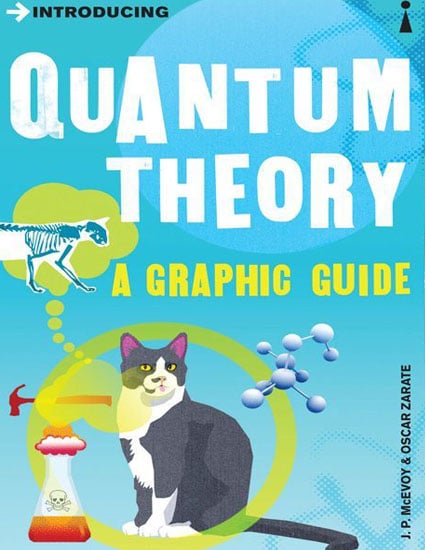Description
Originating editor: Richard Appignanesi No part of this book may be reproduced in any form, or by any
means, without prior permission in writing from the publisher.
Contents
Cover
Title Page
Copyright
What is Quantum Theory?
Classical Physicists
It’s All Proven (and Classical). . .
“Fill in the Sixth Decimal Place”
The Fundamental Assumptions of Classical Physics
The Solvay Conference 1927 – Formulation of Quantum Theory
The First Law of Thermodynamics
Rudolf Clausius: Two Laws
The Existence of Atoms
Averaging Diatomic Molecules
Ludwig Boltzmann and Statistical Mechanics
Thermal Equilibrium and Fluctuations
The Thirty Years War (1900–30) – Quantum Physics Versus Classical Physics
Black-Body Radiation
Paradoxical Results
What Went Wrong?
The Ultraviolet Catastrophe
Enter Max Planck
Pre-Atomic Model of Matter
Planck’s Predicament
Chopping Up the Energy
A Quantum of Energy
The Photoelectric Effect
A Classical Interpretation
Enter Albert Einstein
A Small Flat at Kramergasse 49, in Bern
Einstein’s Explanation of the Photoelectric Effect
Millikan: Hard-headed Classical Physicist
Bright Line Light Spectra
Emission Spectra
Absorption Spectra (Dark Lines)
Fraunhofer Lines
The Discovery of Helium
Hydrogen – Test Case for Atomic Structure
Balmer: the Swiss School Teacher
Hydrogen Frequencies From Balmer’s Formula
Discovery of the Electron
Christmas Pudding Atom
Rutherford’s Nuclear Atom
Size of the Nucleus
Arrival of the Quantum Hero, Niels Bohr
Bohr Meets Nicholson: Quantized Angular Momentum
First: Linear Momentum
Second: Angular Momentum
The Bohr Quantum Postulates
Mixing Classical and Quantum Physics
Bohr Derives the Balmer Formula
A Closer Look at Spectra . . . and More Lines
Another Quantum Number Added, k
The Zeeman Effect . . . and Still More Lines
Three Quantum Numbers, n, k, m
Wolfgang Pauli: the Anomalous Zeeman Effect, Electron Spin and the Exclusion
Principle
The Pauli Effect
Pauli’s “Hidden Rotation” and the Spinning Electron
Pauli’s Exclusion Principle
Closed Shells and Inert Gases
The Wave/Particle Duality
Properties of Waves
Wave Speed
Diffraction and Interference
Einstein . . . a Lone Voice
A French Prince Discovers Matter Waves
An Associated Wave
Dramatic Conclusions
An Astounding Thesis
Confirmation of Matter Waves
Electron Waves in Atoms
Visualizing the Atom: the “Old Quantum Theory”
Triple Birth of the New Quantum Theory
Heisenberg, Genius and Mountain-Climber
Heisenberg’s Picture of the Atom
Max Bom and Matrix Mechanics
Pauli Shows Matrix Mechanics is Correct
Erwin Schrödinger – Genius and Lover
Schrödinger’s Equation
Fourier Wave Analysis of Periodic Functions
Visualizing Schrödinger’s Atom
The Balmer Formula, the Zeeman Effect and All That
Schrödinger: a Return to Classical Physics?
Who Needs Particles Anyway?
Two Theories, One Explanation
Schrödinger Meets Heisenberg
Max Born: the Probability Interpretation of ψ
Two Kinds of Probability
Schrödinger’s Cat. . . The Quantum Measurement Problem
Consciousness and the Collapsing Wave Function
Paul Adrian Maurice Dirac: Genius and Recluse
Dirac’s Version of Quantum Mechanics
Dirac’s Transformation Theory
The Beginning of Quantum Electrodynamics
The Dirac Equation and Electron Spin
The Prediction of Anti-Matter
The Uncertainty Principle
Heisenberg’s Gamma-Ray Microscope
The Breakdown of Determinism
Complementarity
The Copenhagen Interpretation
Como, Italy, September 1927
The Solvay Conference, October 1927
Einstein’s Box of Light
A Sleepless Night
The EPR Paradox
The Locality Principle
Bohr and Non-Locality
Bell’s Inequality Theorem
An Undiscovered World
Quantum Theory and the New Millennium
John Archibald Wheeler, Quantum Physicist
A Final Word
Further Reading
Acknowledgements
Index









Reviews
There are no reviews yet.